Kpe160 - Study guides, Class notes & Summaries
Looking for the best study guides, study notes and summaries about Kpe160? On this page you'll find 26 study documents about Kpe160.
Page 2 out of 26 results
Sort by
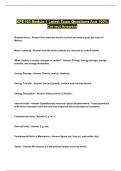
-
KPE160 Module 1 Latest Exam Questions And 100% Correct Answers
- Exam (elaborations) • 12 pages • 2024
- Available in package deal
-
- $11.99
- + learn more
KPE160 Module 1 Latest Exam Questions And 100% Correct Answers...
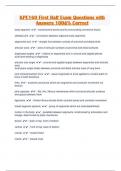
-
KPE160 First Half Exam Questions with Answers 100% Correct
- Exam (elaborations) • 8 pages • 2024
-
- $13.89
- + learn more
KPE160 First Half Exam Questions with Answers 100% Correct KPE160 First Half Exam Questions with Answers 100% Correct KPE160 First Half Exam Questions with Answers 100% Correct KPE160 First Half Exam Questions with Answers 100% Correct KPE160 First Half Exam Questions with Answers 100% Correct KPE160 First Half Exam Questions with Answers 100% Correct KPE160 First Half Exam Questions with Answers 100% Correct KPE160 First Half Exam Questions with Answers 100% Correct KPE160 First Half Exam Quest...
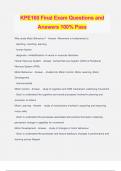
-
KPE160 Final Exam Questions and Answers 100% Pass
- Exam (elaborations) • 34 pages • 2024
- Available in package deal
-
- $13.49
- + learn more
KPE160 Final Exam Questions and Answers 100% Pass Why study Motor Behaviour? - Answer- Movement is fundamental to: - teaching, coaching, learning - human factors - diagnosis / rehabilitization of neural or muscular disorders Human Nervous System - Answer- Central Nervous System (CNS) & Peripheral Nervous System (PNS) Motor Behaviour - Answer- - divided into Motor Control, Motor Learning, Motor Development - interconnected Motor Control - Answer- - study of cognitive and CNS mechanism ...
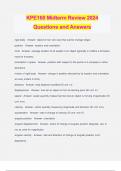
-
KPE160 Midterm Review 2024 Questions and Answers
- Exam (elaborations) • 31 pages • 2024
- Available in package deal
-
- $13.49
- + learn more
KPE160 Midterm Review 2024 Questions and Answers rigid body - Answer- object of non-zero size that cannot change shape position - Answer- location and orientation CoG - Answer- average location of all weight of an object (typically in midline a bit below navel of humans) orientation in space - Answer- position with respect to the points of a compass or other directions motion of rigid body - Answer- change in position denoted by its location and orientation at every instant in time) di...
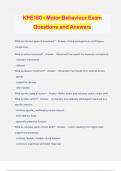
-
KPE160 - Motor Behaviour Exam Questions and Answers
- Exam (elaborations) • 41 pages • 2024
- Available in package deal
-
- $13.49
- + learn more
KPE160 - Motor Behaviour Exam Questions and Answers What are the two types of movement? - Answer- Active (endogenous) and Passive (exogenous) What is active movement? - Answer- - Movement that results fro muscular contractions - voluntary movements - reflexes What is passive movement? - Answer- - Movement that results from external forces - gravity - supportive devices - other bodies What are the types of action? - Answer- Reflex action and voluntary action (motor skill) What is refl...
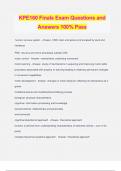
-
KPE160 Finals Exam Questions and Answers 100% Pass
- Exam (elaborations) • 22 pages • 2024
- Available in package deal
-
- $12.49
- + learn more
KPE160 Finals Exam Questions and Answers 100% Pass human nervous system - Answer- CNS: brain and spinal cord encased by skull and vertebrae PNS: neurons and nerve processes outside CNS motor control - Answer- mechanisms underlying movement motor learning - Answer- study of mechanisms in acquiring and improving motor skills processes associated with practice or learning leading to relatively permanent changes in movement capabilities motor development - Answer- changes in motor behavior ...
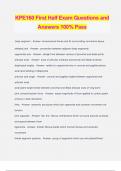
-
KPE160 First Half Exam Questions and Answers 100% Pass
- Exam (elaborations) • 11 pages • 2024
- Available in package deal
-
- $12.49
- + learn more
KPE160 First Half Exam Questions and Answers 100% Pass body segment - Answer- bone/several bones and its surrounding connective tissue skeletal joint - Answer- connection between adjacent body segments segmental axis - Answer- straight line between centres of proximal and distal joints articular axes - Answer- axes of articular surfaces at proximal and distal surfaces diaphyseal angles - Answer- relative to segmental axis in coronal and sagittal planes axial lane twisting of diaphyses ar...
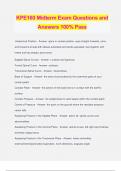
-
KPE160 Midterm Exam Questions and Answers 100% Pass
- Exam (elaborations) • 10 pages • 2024
- Available in package deal
-
- $12.49
- + learn more
KPE160 Midterm Exam Questions and Answers 100% Pass Anatomical Position - Answer- spine in neutral position, eyes straight forwards, arms and forearms at side with elbows extended and hands supinated, feet together with knees and hip straight, penis erect Sagittal Spinal Curves - Answer- Lordosis and kyphosis Frontal Spinal Curve - Answer- scoliosis Transverse Spinal Curve - Answer- rotoscoliosis Base of Support - Answer- the area circumscribed by the outermost parts of your contact pat...

-
KPE160 midterm Exam Questions and Answers 100% Pass
- Exam (elaborations) • 10 pages • 2024
- Available in package deal
-
- $7.99
- + learn more
KPE160 midterm Exam Questions and Answers 100% Pass Space - Answer- distance is the linear measure of space (m,km,cm) Space and planar angle - Answer- a figure made by two intersecting lines or planes, an angular measure of space (radians, degrees, revolutions) Time - Answer- monotonically increasing quantity (s) Matter - Answer- Anything that has mass and takes up space Mass(m) - Answer- how much matter is in a material body (kg) Volume(V) - Answer- How much space an object takes up (L)...

-
KPE160 DOUG PREP QUESTIONS AND ANSWERS 100% PASS
- Exam (elaborations) • 17 pages • 2024
- Available in package deal
-
- $12.49
- + learn more
KPE160 DOUG PREP QUESTIONS AND ANSWERS 100% PASS Centre of Gravity vs Centre of Mass - Answer- centre of mass depends on the distribution of mass (not gravitational field) and it doesn't change even if you move or orient yourself differently. Centre of gravity is a unique point which weight is balanced, it can change based on orientation and also takes into account mass distribution. Is it harder to lift or lower a mass? Which feels harder and why? - Answer- It takes the same amount of f...

How much did you already spend on Stuvia? Imagine there are plenty more of you out there paying for study notes, but this time YOU are the seller. Ka-ching! Discover all about earning on Stuvia


